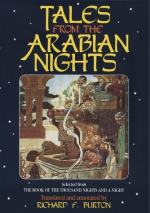centuries. The Caliph Mu’awiyah when passing
the cave sent into it some explorers who were all
killed by a burning wind. The number of the sleepers
remains uncertain, according to the Koran (ibid. v.
21) three, five or seven and their sleep lasted either
three hundred or three hundred and nine years.
The dog (ibid. v. 17) slept at the cave-entrance with
paws outstretched and, according to the general, was
called “Katmir” or “Kitmir;”
but Al-Rakim (v. 8) is also applied to it by some.
Others hold this to be the name of the valley or mountain
and others of a stone or leaden tablet on which their
names were engraved by their countrymen who built a
chapel on the spot (v. 20). Others again make
the Men of Al-Rakim distinct from the Cave-men, and
believe (with Bayzawi) that they were three youths
who were shut up in a grotto by a rock-slip.
Each prayed for help through the merits of some good
deed: when the first had adjured Allah the mountain
cracked till light appeared; at the second petition
it split so that they saw one another and after the
third it opened. However that may be, Kitmir
is one of the seven favoured animals: the others
being the Hudhud (hoopoe) of Solomon (Koran xxii.
20); the she-camel of Salih (chaps. Ixxxvii.);
the cow of Moses which named the Second Surah; the
fish of Jonah; the serpent of Eve, and the peacock
of Paradise. For Koranic revelations of the Cave
see the late Thomas Chenery (p. 414 The Assemblies
of Al-Hariri: Williams and Norgate, 1870) who
borrows from the historian Tabari.
[FN#149] These lines have occurred in Night cxlvi.:
I quote Mr. Payne by way of variety.
[FN#150] The wolf (truly enough to nature) is the
wicked man without redeeming traits; the fox of Arab
folk-lore is the cunning man who can do good on occasion.
Here the latter is called “Sa’alab”
which may, I have noted, mean the jackal; but further
on “Father of a Fortlet” refers especially
to the fox. Herodotus refers to the gregarious
Canis Aureus when he describes Egyptian wolves as
being “not much bigger than foxes” (ii.
67). Canon Rawlinson, in his unhappy version,
does not perceive that the Halicarnassian means the
jackal and blunders about the hyena.
[FN#151] The older “Leila” or “Leyla”:
it is a common name and is here applied to woman in
general. The root is evidently “layl"=nox,
with, probably, the idea, “She walks in beauty
like the night.”
[FN#152] Arab. Abu ’l-Hosayn; his hole
being his fort (Unexplored Syria, ii. 18).
[FN#153] A Koranic phrase often occurring.
[FN#154] Koran v. 35.
[FN#155] Arab. “Bazi,” Pers.
“Baz” (here Richardson is wrong s.v.);
a term to a certain extent generic, but specially used
for the noble Peregrine (F. Peregrinator) whose
tiercel is the Shahin (or “Royal Bird").
It is sometimes applied to the goshawk (Astur palumbarius)
whose proper title, however, is Shah-baz (King-hawk).
The Peregrine extends from the Himalayas to Cape Comorin




